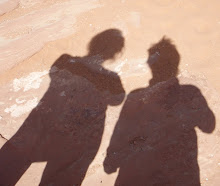We went to two events: Be Yourself, a modern dance performance by the Australian Dance Troupe, and Tripod vs. The Dragon, a musical comedy. We thoroughly enjoyed both performances, which came as sort of surprise since we’re not all that into contemporary dance, and we weren’t sure whether we would get the Australian sense of humor. Turns out, we enjoyed the comedy more than our Australian friends who recommended it. The dance performance was unlike anything we’d ever seen before, and was essentially a dance of all parts of your body, including organs, muscles, and emotions. It was an intense experience, but very well done.
The dance performance was part of the Adelaide Festival, and the comedy was part of the Fringe Festival. They call it the Fringe Festival because a lot of the performances are pretty out there—definitely left of center, and not at all standard performances.
The name of the festival is fitting, but I think the real fringe in Australia is the small, slightly green, mostly-habitable areas on the edge of the continent. I’m reading this book right now called Country by Tim Flannery, and I highly recommend it. In the book, he and his friend decide to ride their little motorbikes around the country. The trip sounds seriously rugged, but he mentions how easy it is in Australia to slip out of the green, habitable parts of the country and into the red, hot, dry, sun and wind-blasted parts of the interior.
Our neighbors leant us a documentary of Lake Eyre, which really isn’t a lake at all most of the time. However, once about every 40 years or so, when it rains really heavily in Queensland, a massive flood slowly creeps down across the Outback, eventually leading to Lake Eyre, which drains about 1/6th of the continent. In its wake, the flood turns the dessert green, and fish, amphibians, and birds magically appear to eat, breed, and hibernate for decades until the next flood comes. It is truly an incredible thing to try and grasp—some of these eggs just sit in dirt waiting for up to 40 years for the water to come. How does something like that evolve? How do the birds know that the water is there in the middle of the continent? How can the frogs lie dormant for years, and then suddenly spring to life and catch insects? How do little country towns survive years of dry dirt and dust, and then suddenly welcome hoards of people who follow the flood waters to Lake Eyre?
We haven’t been to the Outback yet, but we have to go. You can read about it, but I don’t think we’ll really have a good sense for it until we actually experience it. But, even for those of you who might never get to the Outback, I highly recommend Tim Flannery’s books (I’m only part way through Country, but I’ve heard good things about his other books as well.) I also recommend the DVD on Lake Eyre, though I’m not sure if it’s available outside of Australia. Since I’m on a recommending roll, I also think the BBC should do another round of Planet Earth DVDs and include a section on the Australian Outback—of course it may be decades before they could film anything since there was just a flood in 2009. I guess this blog is mostly about how amazing it is that life has adapted to—and even thrives—in some of the world’s harshest environments. I get a little nervous even thinking about the Outback. There’s this saying that if you’re not living on the edge, you’re taking up too much space. I think in Australia, if you’re not living on the edge, you either don’t need fresh water to survive (some kangaroos can survive on salt water), you’re able to wait several decades before hatching from your egg (like the fish and amphibians), you live under ground (people really do in Coober Pedy), or you can cover yourself in a ball of slime and patiently await the rain (like some frogs do). Basically, if you’re not living on the edge in Australia, you are one hardy soul.

No comments:
Post a Comment